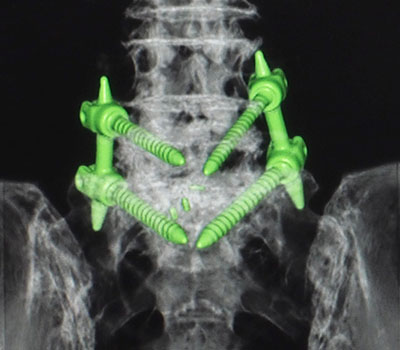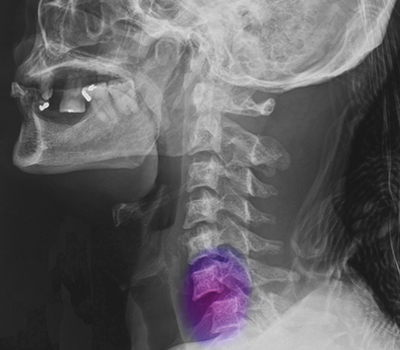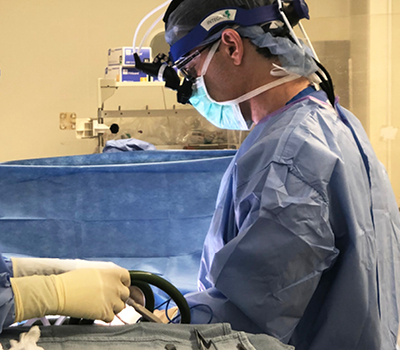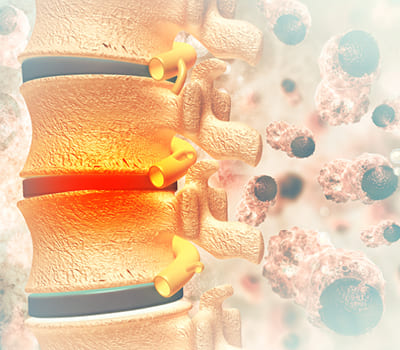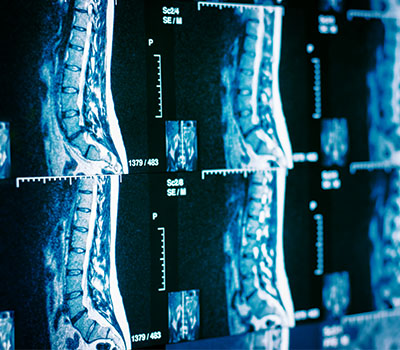SCIATIC NERVE PAIN
SCIATICA
Sciatica
Q & A
WHAT SHOULD I KNOW ABOUT THE LUMBAR SPINE?
To understand sciatic nerve pain, it’s helpful to have a basic understanding of the lumbar and sacral spine anatomy. The lumbar spine is made up of five bones called vertebrae, which are numbered from top to bottom as L1 to L5. The sacral spine follows and includes the next three vertebrae numbered S1 to S3. The lumbar spinal nerves begin with nerve roots that branch from the spinal cord. Each is named for the vertebra immediately above; spinal nerve L4 exits the spinal canal below the lumbar vertebra L4.
The sciatic nerves, which run down each leg, are made up of spinal nerves L4 to S3. These nerves begin in the lower back (lumbar spine) and run down the back of each leg. They are the longest nerves in the body.
WHAT ARE SYMPTOMS OF SCIATICA?
Sciatica, technically called lumbar radiculopathy, causes symptoms that may include lower back pain, but are more intense in the legs. With sciatica, the pain:
- Typically affects one leg and buttock, rarely both sides
- Feels sharp instead of dull or achy
- May be accompanied by numbness, tingling, and/or weakness that may affect the leg and foot
- Improves when lying down or walking
- Intensifies when sitting or standing for extended periods
It’s important to seek medical help immediately if you are suddenly unable to control your bladder or bowels.
Sciatica Overview
WHAT ARE CAUSES OF SCIATICA NERVE PAIN?
Sciatica is usually caused by inflammation or pressure on the nerve roots that make up the sciatic nerve which may be caused by:
- Lumbar Disc Herniation
- Lumbar Spinal Stenosis
- Degenerative disc disease
HOW IS SCIATICA DIAGNOSED?
Minor sciatica symptoms will often resolve over time. If symptoms are intense and continue for several weeks, or result from a sudden injury, it’s likely you need treatment. Dr. Giordano and Dr. Nachwalter are highly experienced in diagnosing the causes of sciatica and other spinal disorders as well as providing both surgical and non-surgical care. During your consultation, your doctor will:
- Review your symptoms (such as where you have pain, weakness, and numbness) and what limitations these symptoms place on your everyday activities
- Perform a physical exam including an assessment of nerve function, muscle strength, response to sensory input (pressure and sensations such as touch) and check reflexes
- Evaluate your medical history
- Order diagnostic tests such as x-rays, CT and MRI scans or review the results of scans you have already had
Your doctor will review treatment options once he has diagnosed your condition and determined the cause of your symptoms. He will review the risks and benefits of each option and assist you in deciding which one is best for you.
WHAT ARE THE TREATMENTS FOR SCIATICA?
Dr. Giordano and Dr. Nachwalter take a conservative approach to treatment by recommending non-surgical treatments whenever possible. Treatment options for sciatica may include one or a combination of the following:
- Modified activity
- Medication
- Physical therapy
- Lumbar Discectomy or Lumbar Laminectomy when symptoms persist or are severe
Atlantic Spine Specialists
SPECIALTIES & CONDITIONS
 88 Reviews
88 Reviews
 120 Reviews
120 Reviews
 149 Reviews
149 Reviews
 4 Reviews
4 Reviews












